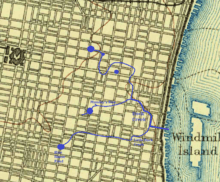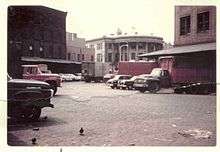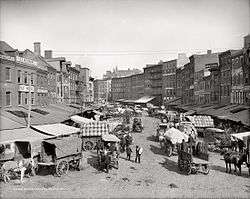Dock Street Market
|
Dock Street Market in Philadelphia facing north from Spruce Street. Photo circa 1910. | |
| Location | Philadelphia |
|---|---|
| Opening date | 1870 |
| Closing date | 1959 |
| No. of anchor tenants | Over 100 |
The Dock Street Market was Philadelphia’s wholesale produce market. It was located on Dock Street in Society Hill. Dock Street is three blocks long, and runs from Sansom Street to Spruce Street, and between Third and Front Streets. The market was busiest between midnight and eight in the morning when produce was loaded and offloaded between delivery trucks and warehouses. The Dock Street Market was the center of the region's wholesale produce distribution when the market closed and moved to the Food Distribution Center in South Philadelphia in 1959.
Dock Creek

The area around Dock Creek was first settled in the seventeenth century.[1] William Penn thought the mouth of the creek a good site to dock ships.[2]
Leather tanners had used Dock Creek since the city's early days, both as a water source in which to soak animal hides, and for refuse disposal. Benjamin Franklin and others petitioned to remove the tanners to a more remote part of the city in 1739. The city built a covered sewer with a brick arch, in two stages, in 1765 and 1784.[3] In 1763, the creek was used as an open sewer and described as "a Receptacle for the Carcasses of dead Dogs, and other Carrion, and Filth of various kinds, which laying exposed to the Sun and Air putrify and become extremely offensive and injurious to the Health of the Inhabitants."[4] Residents covered the creek above Second Street by 1769[5] and Dock Creek was completely covered to its outlet at the Delaware by 1784.[5]
The sewer became inadequate in the 1840s and frequently overflowed to the streets above.[6] The city built a culvert under the streets to carry the stream. During the redevelopment of Dock Street in the 1960s, new sewer lines were constructed in the area and archaeologists investigated the site.[7]
Dock Street continues to run on top of the old stream bed.
1870-1959
In June 1842, Philadelphia's municipal council referred to the Committee on Police a proposal, "...asking that the stands for Market Wagons, vending their produce, may be changed from [Second street, between Chestnut and High streets] to Dock street, between Second and Front."[8]In 1958, Dock Street was one of four major produce markets in Philadelphia alongside the Callowhill Street Market, the Baltimore and Ohio Produce Terminal (used for auction sales only), and the Pennsylvania Railroad.[9]
Move to South Philadelphia

In the late 1950s, Society Hill was considered a slum neighborhood,[10] and the market had come to be known for its congestion and noise in the early morning hours, and the infestation of vermin that fed on the discarded produce. Edmund Bacon, city planning director, convinced the city to spend $17 million to acquire land and invest in infrastructure.[11] The Philadelphia City Planning Commission and the Redevelopment Authority targeted Society Hill including the market [12] From 1957-1959, the Greater Philadelphia Movement, the Redevelopment Authority and the Old Philadelphia Development Corporation bought 31 acres (130,000 m2) around Dock Street. They relocated and demolished the Dock Street market, setting aside 5 acres (20,000 m2) of land that would become the Society Hill Towers.[13] The United States Department of Agriculture published a study in 1951 supporting the move of the market to Delaware and Oregon Avenues in South Philadelphia.[14]
In June 1959, the Dock Street Market merchants moved to the new Food Distribution Center on South Galloway Street in South Philadelphia.
The move from Dock Street to the Food Distribution Center in 1959 changed the structure of the wholesale produce market by centralizing distribution through a fewer number of larger wholesalers. Alfred Joseph Burns wrote in 1968,
Most of the 1958-64 decline in the number of wholesalers was among small firms. In 1958 there were 117 small firms handling less than 3,000 tons of produce a year, 35 medium-sized firms handling from 3,000 to 7,500 tons, and 55 large firms handling over 7,500 tons. In 1964 there were 64 small, 39 medium-sized, and 51 large firms.[15]
Historiography
An art project in 2008 investigated the former course of Dock Creek between Third and Fifth Streets, in what is now Independence National Historical Park.[16]
The Dock Street Market was the subject of "Hucksters: The Tumult of Dock Street"[17] at the Independence Seaport Museum in 2015.
References
- ↑ "Delaware Direct Watershed History". phillywatersheds.org. Philadelphia Water. 2016. Retrieved 2016-08-02.
- ↑ Philadelphia Times 1889.
- ↑ Levine, Adam (November 14, 2005). "Dock Creek Sewer in 1849: A report on its condition made to City Councils". Philly H20. Adam Levine. Retrieved 2016-07-31.
- ↑ Olton 1974, p. 92.
- 1 2 Cotter 1992, p. 235.
- ↑ Topo 1849.
- ↑ Cotter 1992, p. 236.
- ↑ Journal of the Common Council of the City of Philadelphia for the Year 1841-1842. Philadelphia: J. Crissy, Printer. 1842. p. 117.
- ↑ Podany, Joseph Constantine (1962). The Organization of the Wholesale Fruit and Vegetable Market in Philadelphia. U.S. Department of Agriculture, Economic Research Service, Marketing Economics Division. p. 2.
- ↑ Gallery, John Andrew, ed. (2004), Philadelphia Architecture: A Guide to the City (2nd ed.), Philadelphia: Foundation for Architecture, ISBN 0962290815, p.119
- ↑ Garvin, Alexander (January 1, 2011). "Greener Cities: A Public Realm Approach". In Birch, Eugenie L.; Wachter, Susan M. Growing Greener Cities: Urban Sustainability in the Twenty-First Century. Philadelphia: University of Pennsylvania Press. p. 81. ISBN 0812204093. Retrieved 2016-08-01.
- ↑ "History" on the Society Hill Towers website
- ↑ Le Faivre-Rochester, Carole. "Society Hill Towers: A Bold and Graceful Venture" in Baron, Herman (ed.) I.M. Pei and Society Hill: A 40th Anniversary Celebration. Philadelphia: Diane Publishing Co., 2003, p.35
- ↑ United States. Dept. of Agriculture. Production and Marketing Administration; Pennsylvania State College. Agricultural Extension Service (1951). Wholesale produce market facilities for Philadelphia, Pa. Washington, DC.
- ↑ Burns, Alfred Joseph. The Changing Structure of the Philadelphia Wholesale Fruit and Vegetable Market. U.S. Department of Agriculture, Economic Research Service. p. 4.
- ↑ Lutz 2008.
- ↑ http://www.newsworks.org/index.php/local/arts-culture/82929-seaport-museum-charts-boisterous-beginnings-of-dock-street-photos
Further reading
- Cresson, John C., Phillip M. Price, and Solomon W. Roberts, and Marine T. W. Chandler (June 13, 1849). Report of the Topographical Commissioners appointed by the Committee on Public Highways, March 15, 1849, To Make a Survey of the region of Dock Street, with a view to ascertain the best system of Drainage. Read in the Select and Common Councils of the City of Philadelphia (Report). Philly H2O. Retrieved 2016-07-31.
- Perrine, William (January 27, 1919). "Dock Street". Evening Bulletin. Philadelphia. Retrieved 2016-07-31.
